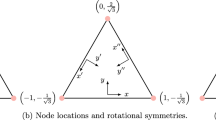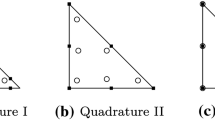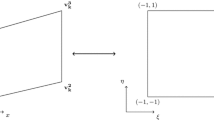Abstract
The flux reconstruction (FR) approach allows various well-known high-order schemes, such as collocation based nodal discontinuous Galerkin (DG) methods and spectral difference (SD) methods, to be cast within a single unifying framework. Recently, the authors identified a new class of FR schemes for 1D conservation laws, which are simple to implement, efficient and guaranteed to be linearly stable for all orders of accuracy. The new schemes can easily be extended to quadrilateral elements via the construction of tensor product bases. However, for triangular elements, such a construction is not possible. Since numerical simulations over complicated geometries often require the computational domain to be tessellated with simplex elements, the development of stable FR schemes on simplex elements is highly desirable. In this article, a new class of energy stable FR schemes for triangular elements is developed. The schemes are parameterized by a single scalar quantity, which can be adjusted to provide an infinite range of linearly stable high-order methods on triangular elements. Von Neumann stability analysis is conducted on the new class of schemes, which allows identification of schemes with increased explicit time-step limits compared to the collocation based nodal DG method. Numerical experiments are performed to confirm that the new schemes yield the optimal order of accuracy for linear advection on triangular grids.
Similar content being viewed by others
References
Carpenter, M.H., Kennedy, C.: Fourth-order 2n-storage Runge-Kutta schemes. Technical Report TM 109112, NASA, NASA Langley Research Center (1994)
Castonguay, P., Liang, C., Jameson, A.: Simulation of transitional flow over airfoils using the spectral difference method. In: 40th AIAA Fluid Dynamics Conference, Chicago, IL, June 28–July 1 (2010). AIAA Paper, 2010-4626
Cockburn, B., Shu, C.W.: TVB Runge-Kutta local projection discontinuous Galerkin finite element method for conservation laws II: general framework. Math. Comput. 52(186), 411–435 (1989)
Cockburn, B., Shu, C.W.: The Runge-Kutta local projection P1-discontinuous Galerkin finite element method for scalar conservation laws. RAIRO Modél. Math. Anal. Numér. 25(3), 337–361 (1991)
Cockburn, B., Shu, C.W.: Runge-Kutta discontinuous Galerkin methods for convection-dominated problems. J. Sci. Comput. 16(3), 173–261 (2001)
Cockburn, B., Lin, S.Y., Shu, C.W.: TVB Runge-Kutta local projection discontinuous Galerkin finite element method for conservation laws III: one-dimensional systems. J. Comput. Phys. 84(1), 90–113 (1989)
Cockburn, B., Hou, S., Shu, C.W.: The Runge-Kutta local projection discontinuous Galerkin finite element method for conservation laws. IV: The multidimensional case. Math. Comput. 54(190), 545–581 (1990)
Dubiner, M.: Spectral methods on triangles and other domains. J. Sci. Comput. 6(4), 345–390 (1991)
Hesthaven, J.S., Warburton, T.: Nodal Discontinuous Galerkin Methods: Algorithms, Analysis, and Applications. Springer, Berlin (2007)
Huynh, H.T.: A flux reconstruction approach to high-order schemes including discontinuous Galerkin methods. In: 18th AIAA Computational Fluid Dynamics Conference, Miami, FL, Jun 25–28 (2007). AIAA Paper, 4079
Huynh, H.T.: A reconstruction approach to high-order schemes including discontinuous Galerkin for diffusion. In: 47th AIAA Aerospace Sciences Meeting, Orlando, FL, Jan 5–8 (2009). AIAA Paper, 403
Jameson, A.: A proof the stability of the spectral difference method for all orders of accuracy. J. Sci. Comput. 45(1–3), 348–358 (2010)
Kannan, R., Wang, Z.J.: A study of viscous flux formulations for a p-multigrid spectral volume Navier Stokes solver. J. Sci. Comput. 41(2), 165–199 (2009)
Kannan, R., Wang, Z.J.: LDG2: A variant of the LDG flux formulation for the spectral volume method. J. Sci. Comput. 46(2), 314–328 (2011)
Kopriva, D.A., Kolias, J.H.: A conservative staggered-grid Chebyshev multidomain method for compressible flows. J. Comput. Phys. 125, 244–261 (1996)
Liang, C., Kannan, R., Wang, Z.J.: A p-multigrid spectral difference method with explicit and implicit smoothers on unstructured triangular grids. Comput. Fluids 38, 254–265 (2009)
Liu, Y., Vinokur, M., Wang, Z.J.: Spectral difference method for unstructured grids i: Basic formulation. J. Comput. Phys. 216, 780–801 (2006)
Raviart, P.A., Thomas, J.M.: A mixed hybrid finite element method for the second order elliptic problems. In: Mathematical Aspects of the Finite Element Method. Lectures Notes in Mathematics. Springer, Berlin (1977)
Reed, W.H., Hill, T.R.: Triangular mesh methods for the neutron transport equation. Los Alamos Report LA-UR-73-479 (1973)
Roe, P.L.: Approximate Riemann solvers, parameter vectors and difference schemes. J. Comput. Phys. 43, 357–372 (1981)
Van den Abeele, K., Lacor, C., Wang, Z.J.: On the stability and accuracy of the spectral difference method. J. Sci. Comput. 37(2), 162–188 (2008)
Vincent, P.E., Castonguay, P., Jameson, A.: A new class of high-order energy stable flux reconstruction schemes. J. Sci. Comput. 47(1), 50–72 (2011)
Wang, Z.J., Gao, H.: A unifying lifting collocation penalty formulation including the discontinuous Galerkin, spectral volume/difference methods for conservation laws on mixed grids. J. Comput. Phys. 228(21), 8161–8186 (2009)
Wang, Z.J., Liu, Y., May, G., Jameson, A.: Spectral difference method for unstructured grids II: Extension to the Euler equations. J. Sci. Comput. 32, 45–71 (2007)
Zhang, M., Shu, C.W.: An analysis of three different formulations of the discontinuous Galerkin method for diffusion equations. Math. Models Methods Appl. Sci. 13(3), 395–414 (2003)
Author information
Authors and Affiliations
Corresponding author
Rights and permissions
About this article
Cite this article
Castonguay, P., Vincent, P.E. & Jameson, A. A New Class of High-Order Energy Stable Flux Reconstruction Schemes for Triangular Elements. J Sci Comput 51, 224–256 (2012). https://doi.org/10.1007/s10915-011-9505-3
Received:
Revised:
Accepted:
Published:
Issue Date:
DOI: https://doi.org/10.1007/s10915-011-9505-3




